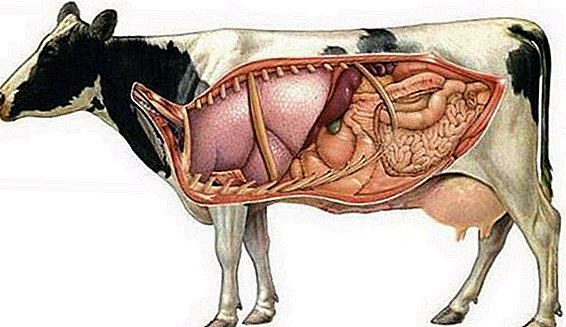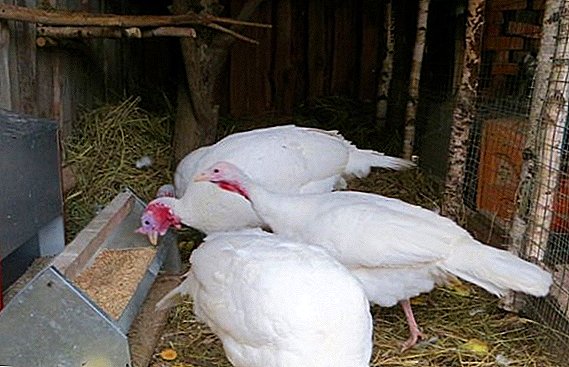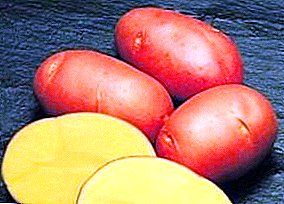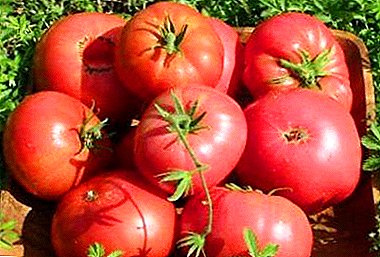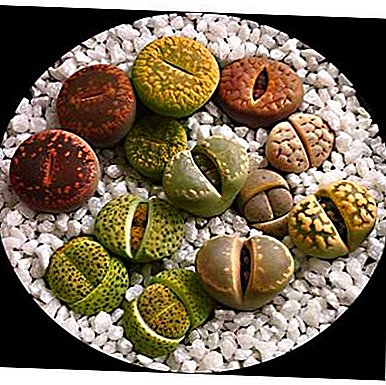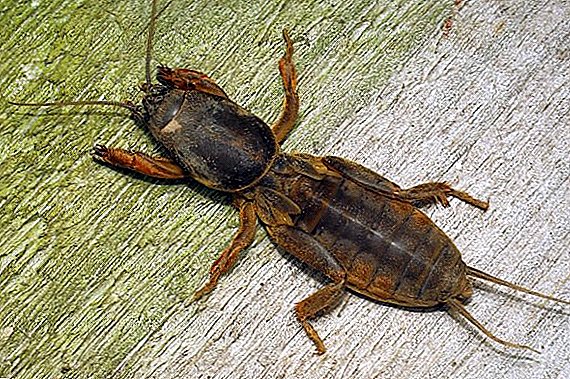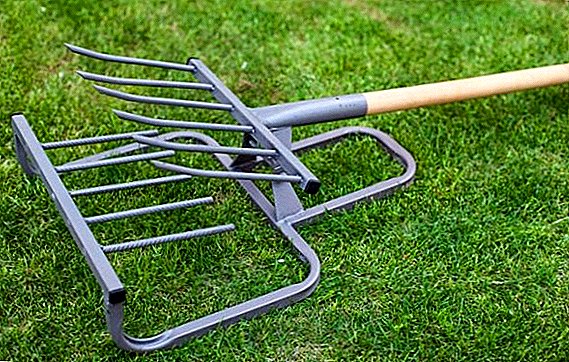 When growing gooseberry on your own plot, you want to choose a plant that, with minimal care, will show high productivity. These are the characteristics of the Phenice variety. This kind of "northern grapes" has gained immense popularity among gardeners due to large, tasty berries, consistently good yields and simple agricultural techniques. On the features of the cultivation of gooseberry varieties "Date" talk further.
When growing gooseberry on your own plot, you want to choose a plant that, with minimal care, will show high productivity. These are the characteristics of the Phenice variety. This kind of "northern grapes" has gained immense popularity among gardeners due to large, tasty berries, consistently good yields and simple agricultural techniques. On the features of the cultivation of gooseberry varieties "Date" talk further.
Description and characteristics
To date, it is not known by whom and when the cultivar "Phenicus" (aka "Goliath") was developed. Some believe that it appeared as a result of popular selection in the territory of Western Europe. The variety belongs to late-ripening, large-fruited and high-yielding, frost-resistant.
Did you know? A great contribution to the selection of gooseberries made the British. The humid and relatively warm climate of this country could not be better suited for growing gooseberries, because over the years of selection, the British were able to achieve an increase in berries 4 times! After that, the berry gained popularity in France, Germany, the Netherlands and other European countries.
Shrub
Bushes are powerful, spreading, vigorous, require a lot of space, grow up to 200 cm. The shoots are thick and strong, can be straight or curved, along the entire length, except for the tops, covered with single spikes. The leaves are dark green, medium in size, may be smooth or wrinkled. The root system is well developed, reaching up to 2 m in depth, which is why the gooseberry easily tolerates small moisture deficiencies. During the flowering period, the bushes are covered with small green-white flowers. 
Berries
One of the main advantages of this variety is berries. They are characterized large sizes: on one-year-old shoots - up to 25 g, on older shoots - reach 15 g. Unevenly painted in a beautiful wine color, regular round shape or pear-shaped.
The skin is dense and thick, covered with a light wax coating, due to which the berry lasts a long time both on the bushes (up to 3 weeks) and during transportation. No pubescence. The flesh is colored yellow-green, the acidity is mild, the sugar content is average. Berries are very tasty, have a strong aroma.
Important! With prolonged rainy seasons berries "Dates" may crack and rot. In the cold and damp summer berries grow smaller.
This variety perfectly tolerates long-term transportation, has a good quality, is suitable for fresh consumption and is considered the best grade for technical processing (berries retain their shape when canned) and making jam, marmalade, marshmallow at home.  For this, the berries are harvested slightly immature. Widely used as a filling for baking, table use, homemade wine, the highlight of which is an unusual ruby color.
For this, the berries are harvested slightly immature. Widely used as a filling for baking, table use, homemade wine, the highlight of which is an unusual ruby color.
Learn more about the beneficial properties and preparation of the gooseberry: recipes for making wine, jam, jam, sauce, pickled gooseberry.
The main characteristics of the variety
The following typical features are typical for the variety:
- Disease and pest resistance. Since the variety is very old and non-hybrid, it is characterized by a typical disease of all berry crops - American powdery mildew, or field library. In order to prevent infection, it is necessary to plant bushes only in well-lit places. In general, the immunity of the "Phenicus" is below average. However, the variety has good resistance to pest attacks.
- Drought tolerance. It is resistant to short dry periods, but long-term drought is destructive for the plant, especially during the formation of ovaries and the ripening of berries.
- Frost resistance. The variety is highly resistant to frost, tolerates temperature drops to + 30 ... +35 ° С.
- Gestation period. The variety is late ripening; in the last decade of July, the berries are at the stage of technical ripeness, full ripening begins in the second half of August.
- Yield. Makes up to 8 kg from one bush for a season on condition of good agrotechnology. However, the yield of "Date" can be increased to 20-25 kg with proper care. Fruiting begins in 4-year-old bushes, the peak of productivity occurs at the age of 8-10 years, lasts up to 25 years.
- Transportability. The berries are well preserved during transportation due to the thick skin and natural wax coating. Well suited for technical processing.
Read also about the treatment of gooseberry disease (powdery mildew) and pest control (firebug).
Planting rules seedlings
Growing gooseberry bushes begins with the proper planting of seedlings. To do this, it is important to know when and where to plant the plants, what the planting process should look like. 
Optimal timing
You can plant gooseberries autumn and springThe choice of the season will depend on the climate in your area. Many gardeners prefer autumn planting, because over the winter the plant will be able to settle well, the soil near the roots will thicken, overgrown roots (weeds) will form at lower positive temperatures, and in spring the plant will quickly grow. In autumn, the gooseberries should be planted from mid-September to mid-October. Calculate the time needed in such a way that before the first frost was at least 2 weeks.
When spring planting is very important to plant seedlings before bud break - right after the snow melts. For different regions, this may occur throughout March; in April, planting of seedlings is no longer done. Remember that during spring planting the germination and survival rate of the crop is much lower.
Read also about the differences and cultivation of the gooseberry varieties "Invicta", "Beryl", "Spring", "Honey", "Krasnoslavyansky", "Consul", "Malachite", "Grushenka", "Komandor", "Kolobok".
Location selection
As we indicated earlier, Finik gooseberry is particularly susceptible to US powdery mildew, however, it is possible to reduce the risk of infection and reduce possible damage if properly planted. To plant a crop, you need to choose places that are well warmed by the sun and protected from strong winds.  In no case can not plant a plant in the lowlands, near water, in shady places. Also thickening of landings is not allowed. Remember that the plant is very branched and has an extensive root system, this should be taken into account when calculating the place for planting.
In no case can not plant a plant in the lowlands, near water, in shady places. Also thickening of landings is not allowed. Remember that the plant is very branched and has an extensive root system, this should be taken into account when calculating the place for planting.
Important! It is impossible to plant gooseberries in places where the groundwater is located close to it, since overmoistening of the soil is very dangerous for the root system of the plant.
It is best to grow crops loamy and sandy fertile soil, with a neutral or slightly acidic pH. Soils with high acidity must be treated with lime. The soil should be nutritious, loose, with high breathability.
Stepwise landing process
It is necessary to plant bushes on a cloudy, windless day. Preparation of holes should begin 2-3 weeks before planting, seedlings also need to be purchased at least 10 days in advance.  In practice, the gooseberry planting consists of such stages:
In practice, the gooseberry planting consists of such stages:
- Previously, the soil at the site of planting should be dug to a depth of 20-25 cm. It must be cleaned of rhizomes and weeds, it is especially important to remove the wheat grass. Next, you need to make the following fertilizers (based on 1 sq. M.): 7-8 kg of manure, 2 kg of potash fertilizers, 4-5 kg of phosphate fertilizers.
- Dig holes up to 40-60 cm in depth, 40 * 40 cm in size. It is important to separate the upper and lower layers of soil into separate piles. Given the size of an adult bush, it is important to keep the distance between rows and bushes: bushes should be at least 1.5 m apart, between rows should be 2 m. In this form, the holes are left for 2-3 weeks.
- The seedlings are soaked in a solution of the drug to stimulate the root system.
- After a specified time, proceed to landing. The topsoil is mixed with the following substances: a humus bucket, 200 g of superphosphate, 2 g of potash fertilizers.
- 1/3 of the soil mix is poured into the pit so that a slide forms along the center of the pit.
- The seedlings need to find the root neck, a layer of soil should cover it when planting 6-10 cm.
- Seedlings are placed vertically in the center of the hill, the roots are straightened. Next, the plant is filled with the remaining soil mixture, and the top is covered with soil from the second heap (barren soil).
- Then the ground is slightly compacted, the plants are watered at the rate of 10 liters per bush. The soil must be mulched with sawdust, peat or humus with a layer of 10 cm.
- The shoots of the bush can be slightly trimmed, leaving 4-6 buds on each lash.
In this form, the gooseberry remains to winter, the subsequent care of the plant begins in the spring. If the winter was rather cold and little snowy, the plant can be additionally warmed with any covering material.
We recommend reading about gooseberry breeding methods.
Video: Gooseberry planting
Support structure
Since the bushes of this variety grow very large, powerful and branchy, they need supports. It is most convenient to construct supports from metal or plastic pipes, wooden beams and picket fence. Around the perimeter of the bush usually 3-4 racks are driven in to a height of 50-70 cm, wooden strips or metal pipes are mounted horizontally on them. The depth of hammering the supports should be sufficient for them to bear the weight of an adult plant. 
Basics of seasonal care
Seasonal plant care is not much different from the care of other berry crops. The main processes: watering, fertilization and soil care, pruning and spraying.
Watering
Variety "Phenicia" without damage to health suffers short dry periods, but in no case should not allow complete drying of the earthy coma. But waterlogging is even more damaging to the plant. To determine the level of humidity, take a handful of earth in your hands: if the soil feels wet to the touch, it easily crumbles under the touch of your fingers, but at the same time it does not stick to your hands from over-wetting, then everything is fine.
Regular, timely watering will contribute to the normal formation of ovaries and berries, good ripening of the crop. It is necessary to water the bushes on average 2-3 times a month depending on weather conditions. The soil should be moistened to 40 cm, for this around a bush at a distance of 30 cm from the roots dig a trench to a depth of 15 cm and pour 2-5 buckets of water depending on the size and age of the bush. Water must be separated from the summer temperature.  Be sure to water the plant during the formation of young shoots and ovaries (late May - early June), as well as during the formation of berries and ripening of the crop (late June - early July).
Be sure to water the plant during the formation of young shoots and ovaries (late May - early June), as well as during the formation of berries and ripening of the crop (late June - early July).
Did you know? To date, breeders have bred more than 1,500 varieties of gooseberries.
Soil care
After watering the soil is necessary loosen, weed and mulch. As a result of these procedures, the "breathing" of the soil and roots is improved, and the moisture evaporates more slowly.
The first loosening should be carried out after the snow has melted, since during the autumn-spring period, as a result of rains and melt waters, the soil becomes excessively compacted. In dense soil, moisture evaporates faster, and the roots lose their normal air circulation. After the first procedure, loosening can be done every time after watering, but at least once a month. You must wait until the moisture is absorbed into the soil, and begin to loosen. In the root zone, loosening is carried out with the help of chopper or hoe to a depth of maximum 4 cm in order not to damage the roots. Under the bush, you can dig up the ground a little with a shovel to a depth of 10-12 cm. This procedure is combined with the removal of weeds.
Important! Since August, loosening is not carried out in order to avoid the growth of young shoots that do not have time to get stronger before the frost and die.
At the end, the ground must be mulched with a layer of freshly cut grass, peat or compost 8 cm thick. For young plants, it is useful to mulch not only the root zone, but also the row spacing. At 100 square meters. m will need about 50 kg of peat or 30 kg of manure. Such a mulch will serve as an excellent fertilizer during the subsequent digging of the soil. 
Top dressing
The basic rules of fertilizing culture:
- If during planting a sufficient amount of fertilizer was applied, then during the first three years it is not necessary to add additional potash and phosphorus substances. At this time, you can feed the bushes with nitrogenous fertilizers according to the instructions (in early May and after flowering).
- From the second year and during the whole period of bush life, in the autumn digging, the following supplements are added to the soil: 10 kg of mullein, 50 g of ammonium nitrate, 150 g of wood ash, 80 g of superphosphate.
- In the summer, before harvesting, you can make organic supplements. For this, a litter solution of 1: 4 is prepared, then this slurry is diluted with water to reduce the concentration by a factor of 10 and poured under a bush.
Pruning
So that the shrub does not become impassable thickets, was healthy and brought a lot of harvest, be sure to hold spring and summer pruning. The most suitable moment for the formation of the bush are the spring months, before the onset of active vegetation. Also pruning should be carried out in summer or early autumn, after harvest.
Important! It is very important to carry out spring pruning before the start of sap flow, otherwise the branches will weaken greatly.
In the first year, you need to remove all weak branches, on the remaining shoots leave up to 4 healthy buds, and cut the tops. By this time, up to 6 full-fledged healthy shoots should be formed on the bushes.  Starting from the second year and then throughout life in the spring, weak, damaged branches at the roots should be removed, and last year's shoots should be shortened by 1/3. During the summer, it is necessary to immediately remove the shoots damaged by infections or pests so that the ailment does not spread.
Starting from the second year and then throughout life in the spring, weak, damaged branches at the roots should be removed, and last year's shoots should be shortened by 1/3. During the summer, it is necessary to immediately remove the shoots damaged by infections or pests so that the ailment does not spread.
Learn more about the correct pruning gooseberries.
We have already mentioned that at the peak of productivity are branches of the 6-8th year of life, however, it is important to ensure that there are shoots of different ages on the plant, otherwise the yield of the plant may change at times from year to year. After the bush has reached 10 years of age, it is necessary to regularly remove all old, not fruit-bearing shoots damaged by age.
Winter cold protection
Phenic perfectly tolerates harsh frosty winters, so if the temperature in your area does not drop to -35 ° C, you can do without special protection. But for the shelter of young plants can be used hilling - the root of the plant should be tucked in with a layer of earth up to 10 cm. In very snowy, especially frosty winters, additional protection from any covering materials can be used. 
The advantages and disadvantages of the variety
The advantages of the variety:
- resistant to frost and drought;
- gives high yields;
- high productivity over several decades;
- berries have high taste characteristics, are well transported and stored, can be processed.
Wealthy cultivar "dates":
- due to the strong spreading of bushes, caring for a plant can be problematic;
- matures late;
- Bushes are highly susceptible to infection with US powdery mildew, especially when agrotechnics are disturbed or in adverse weather conditions.
 In general, this variety continues to be worthy of competition to more modern, hybrid varieties of gooseberry. "Phenicia" does not lose its position due to simple farming techniques and high yields. The variety is great for growing in the middle lane, as it tolerates frosts easily. However, a significant disadvantage of the variety may be susceptibility to the sphere library.
In general, this variety continues to be worthy of competition to more modern, hybrid varieties of gooseberry. "Phenicia" does not lose its position due to simple farming techniques and high yields. The variety is great for growing in the middle lane, as it tolerates frosts easily. However, a significant disadvantage of the variety may be susceptibility to the sphere library.


